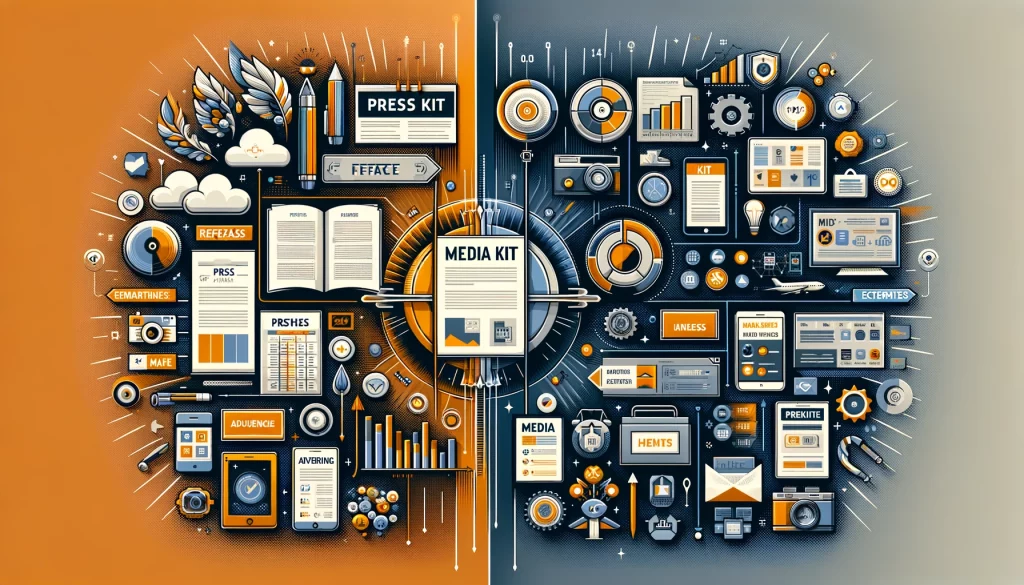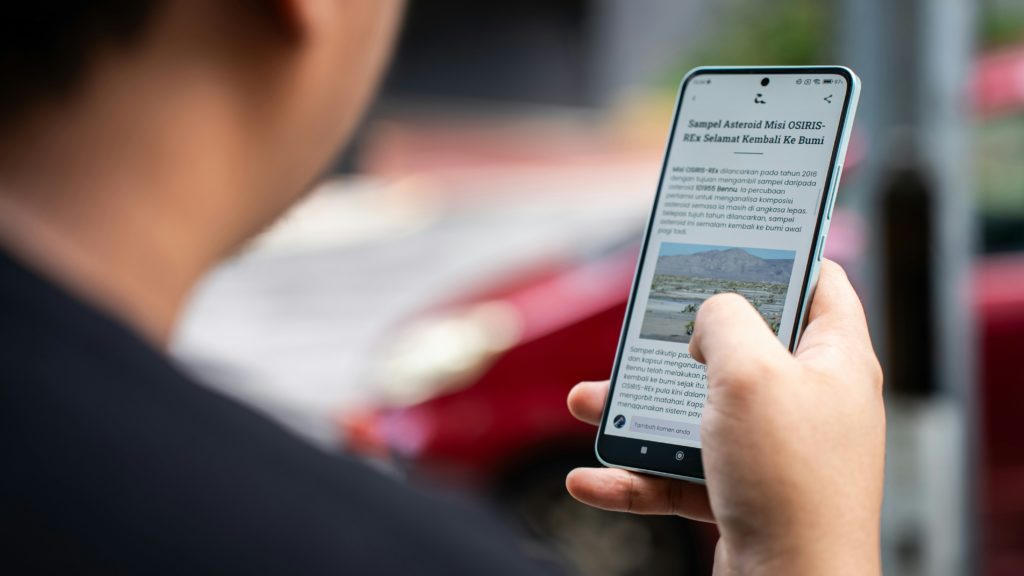
Imagine you’re at a bustling trade show, or maybe you’re launching a new product. Journalists, bloggers, and potential partners are everywhere, and they’re interested in your story. This is where your press and media kits come into play, acting as your brand’s resume and portfolio, showcasing your achievements and value proposition in a clear, compelling way.
Why Every Business Needs a Press and Media Kit
Every business, no matter its size, should have a press and media kit ready to go. These kits serve as a first impression, a chance to tell your story in your own words, and provide valuable information that can lead to media coverage, partnerships, and ultimately, growth. They are your foot in the door, your chance to pique interest and start meaningful conversations.
Press and Media Kits: Your Communication Arsenal
Think of press and media kits as your communication arsenal. They equip you with the tools to effectively convey your message to different audiences. Whether you’re reaching out to journalists, influencers, or potential clients, these kits are tailored to present your brand in the best light possible.
What is a Press Kit
A press kit, also known as a media kit by some, is a packaged set of promotional materials that provides journalists and editors with all the information they need to write about your business. It’s your story, packaged neatly with a bow, ready for the press to unwrap and share with the world.
Purpose:
Press kits are designed to provide journalists and media outlets with all the necessary information to cover your company’s news or event. They’re used to facilitate media coverage, making it easier for reporters to produce comprehensive stories about your company’s achievements, product launches, or significant events.
Structure:
A typical press kit includes a company overview, press releases, biographies of key team members, high-resolution images, and media contact information. It may also contain product fact sheets and recent media coverage.
Length of Content:
Press kits should be concise yet comprehensive, generally ranging from 3 to 6 pages, ensuring that each piece of content adds value and relevance to media professionals.
Usage:
Press kits are ideal for product launches, major company announcements, events, and conferences. They’re distributed to press attendees or made available online to accompany a press release.
Writing Guide: Step-by-Step Creation Process
Crafting an effective press kit involves gathering and presenting comprehensive information about your company, products, or events in a way that appeals to journalists and media outlets. The goal is to make it easy for them to cover your story.
Step-by-Step Creation:
- Start with a Company Overview: Briefly introduce your company, its mission, and core values.
- Include Recent Press Releases: Provide the latest press releases to highlight current news or events.
- Add Executive Biographies: Offer short bios of key team members to personalize the story.
- Incorporate High-Quality Images: Use professional photos of products, executives, and events.
- Provide Product Fact Sheets: Detail the features, benefits, and specifications of your products or services.
- Include Media Coverage: Showcase recent articles, interviews, or features about your company.
- End with Contact Information: Ensure media contacts have easy access to your PR team for follow-up questions.
Elements of an Effective Press Kit:
- Company overview
- Latest press releases
- Executive biographies
- High-resolution images
- Product fact sheets
- Recent media coverage
- Contact information for media inquiries
Tips for an Effective Press Kit:
- Keep content concise and relevant.
- Update your press kit regularly with the latest news and media coverage.
- Ensure all links and contact information are accurate and working.
- Tailor your press kit to reflect your brand’s identity and values.
- Offer your press kit in both digital and physical formats, if possible.
Example of a Press Kit:
Successful press kits often feature a mix of engaging storytelling and factual precision, like Apple’s press kits for product launches, which include detailed product specifications, executive quotes, and high-resolution product images.
What is a Media Kit
On the flip side, a media kit is often directed towards advertisers, potential partners, or sponsors. It’s a showcase of your brand’s reach and influence, aimed at convincing others that aligning with your brand will be beneficial for them.
Purpose:
Media kits are primarily used in marketing and advertising to attract advertisers, sponsors, and partnerships. They showcase the brand’s value proposition, audience demographics, and advertising opportunities, highlighting the brand’s reach and engagement levels.
Structure:
A media kit typically contains information about the company, audience statistics, social media statistics, advertising rates, testimonials, case studies, and contact information for advertising inquiries.
Length of Content:
The content length varies but should be comprehensive enough to provide a clear overview of advertising opportunities while being concise to maintain the reader’s interest. Around 5 to 10 pages is common.
Usage:
Media kits are used when seeking sponsorships, partnerships, or advertising opportunities. They’re often shared at networking events, industry conferences, or directly with potential advertisers or partners.
Writing Guide: Step-by-Step Creation Process
A media kit serves as a comprehensive package designed to attract advertisers, sponsors, and partners by showcasing your brand’s value, audience demographics, and advertising opportunities.
Step-by-Step Creation:
- Brand Overview: Start with an engaging description of your brand and its unique value proposition.
- Audience Demographics: Include detailed information about your audience, such as age, location, interests, and engagement statistics.
- Social Media Statistics: Include metrics from your social media platforms, such as follower count, engagement rates, and audience growth, to demonstrate your online presence and influence.
- Advertising Options: Present the various advertising opportunities available, including rates and specifications.
- Success Stories/Testimonials: Share testimonials or case studies from previous advertisers or partners.
- Contact Information: Provide clear details on how to get in touch for advertising inquiries.
- Update Regularly: Ensure that your media kit contains the most current information and statistics.
- Visual Elements: Incorporate branded visuals and infographics to make the data more accessible and engaging.
Elements of an Effective Media Kit:
- Brand overview
- Audience demographics and statistics
- Social Media Statistics
- Advertising options and rates
- Success stories and testimonials
- Contact information for advertising inquiries
- Regular updates
- Branded visuals and infographics
Tips for an Effective Media Kit:
- Highlight your brand’s strengths and unique selling points.
- Use clear, engaging visuals and infographics to present data.
- Keep the information up-to-date, especially audience statistics and advertising rates.
- Make it easily accessible on your website and in digital format.
- Personalize your media kit for potential advertisers or sponsors to see the value in partnering with your brand.
Example of a Media Kit:
Successful media kits, like those from Vogue or Forbes, detail their audience reach, engagement statistics, and advertising opportunities, coupled with testimonials from previous advertisers and visually appealing layouts.
Differences Between Press Kit and Media Kit
While both press kits and media kits are critical tools in your promotional arsenal, they serve different purposes and audiences. A press kit is geared towards media coverage, providing information that helps journalists write stories about your business. A media kit, meanwhile, is a sales tool designed to attract advertisers or sponsors by showcasing the value of partnering with your brand.
Target Audiences: Whom Are You Reaching?
It’s important to tailor each kit to its intended audience. For a press kit, your target is a journalist or editor—someone looking for the facts and stories that will resonate with their readers. For a media kit, you’re speaking to potential advertisers, sponsors, or partners who are interested in the business potential of aligning with your brand.
Content Breakdown: What Goes Where and When
Understanding the content breakdown is key. A press kit should be timely, relevant, and newsworthy, with materials that can be used to craft a story at a moment’s notice. A media kit, on the other hand, should be evergreen, with a focus on showcasing long-term value and opportunities for collaboration.
Specifics of a Press Kit
Now that we’ve established the distinction between press kits and media kits, let’s delve deeper into the specifics of a press kit. A well-crafted press kit is like a professional handshake—it introduces your brand and provides a lasting impression. It’s an invitation to the media to learn more, cover your story, and spread the word about your business.
Creating a Press Kit: A Timeline
Creating a press kit is not something you should rush. Start by planning a timeline that allows you to gather all the necessary materials. Here’s a quick guide to help you manage your time:
- 4 Weeks Out: Define the goals for your press kit and start gathering content.
- 3 Weeks Out: Draft your press releases and prepare high-quality images and biographies.
- 2 Weeks Out: Design your kit, incorporating your brand’s visual elements.
- 1 Week Out: Review and finalize the content. Make sure every detail is perfect.
- Launch Day: Distribute your press kit to your media list and make it available on your website.
This timeline ensures you have ample time to create a press kit that is thoughtful, well-designed, and comprehensive.
Designing for Impact: Visual Elements in Press Kits
Visual elements play a crucial role in press kits. They grab attention and can often speak louder than words. When designing your press kit, consider the following:
- Use high-resolution images that tell a story about your brand.
- Include infographics to summarize complex data or timelines.
- Choose a color scheme that reflects your brand’s identity.
Remember, the goal is to make your press kit not just informative, but also visually engaging.
Rewriting the Rules: Innovative Press Kit Ideas
It’s time to think outside the traditional press kit box. Why not create an interactive digital press kit with embedded videos and clickable elements? Or how about a press kit that’s also a sample product box, allowing journalists to experience your product first-hand? Get creative—after all, innovation gets noticed.
Press Kit Pitfalls: Common Errors to Avoid
Even the most seasoned professionals can make mistakes when it comes to press kits. Here are some common pitfalls to avoid:
- Overloading your press kit with too much information. Keep it concise.
- Ignoring the importance of a clean, professional design.
- Forgetting to update your press kit regularly with the latest news and achievements.
Steer clear of these errors to ensure your press kit makes the right impression.
Measuring Success: Metrics for Press Kit Performance
How do you know if your press kit is effective? Track metrics like media coverage, website traffic, and engagement on social media. Use tools like Google Analytics to see how many downloads your press kit gets and which sections are most popular. This data will help you refine your approach and improve your kit over time.
Specifics of a Media Kit
Shifting gears to media kits, these are your bridge to potential advertisers, sponsors, and collaborators. They highlight the strengths and opportunities of your brand, serving as a persuasive argument for why others should want to work with you.
Media Kit Analytics: Understanding Your Reach
To convince advertisers and sponsors, you need to understand and effectively communicate your reach. Use analytics to show your audience size, engagement rates, and demographic data. These figures provide a solid foundation for your media kit, demonstrating the potential impact of a partnership with your brand.
Making a Strong First Impression with Your Media Kit
Your media kit is often the first detailed introduction potential partners have to your brand. Make it count. Ensure it’s up-to-date, visually appealing, and reflects your brand’s ethos. Highlight unique selling points and share success stories that resonate with the goals and values of your potential partners.
Customizing Your Media Kit for Different Industries
One size does not fit all when it comes to media kits. Customize your kit to reflect the industry you’re targeting. A fashion brand’s media kit, for example, will focus on visual aesthetics and influencer reach, while a tech company might emphasize innovation and user growth. Tailor your content to speak directly to the interests of your audience.

Crafting Success: The Strategic Power of Press and Media Kits
In wrapping up our exploration of press and media kits, it’s evident that these resources are cornerstone elements of any robust communication strategy. By distinguishing their purposes, understanding their components, and adhering to best practices, businesses can significantly amplify their outreach efforts. Press kits serve as a bridge to the media, offering everything journalists need to craft engaging stories, while media kits cater to potential advertisers and partners, highlighting a brand’s value and audience engagement. As digital dynamics shift, so too should the design and distribution of these kits, ensuring they remain compelling and relevant. Ultimately, well-crafted press and media kits not only elevate a company’s narrative but also open doors to new opportunities and growth, making them indispensable in today’s competitive landscape.
Looking to amplify your digital marketing outcomes?
Explore how AmpiFire can revolutionize your press releases, crafting killer headlines and optimizing your content for wider distribution. Benefit from unparalleled visibility on platforms like Google News, YouTube, SlideShare, Apple Podcasts, and many more…
Click Here To Learn More
Frequently Asked Questions (FAQ)
Regularly update your press or media kit to reflect your latest achievements, offerings, and statistics. Ideally, review and refresh the content every quarter or after significant company milestones.
While combining press and media kits can save time, it’s more effective to keep them separate due to their distinct audiences and purposes. Tailoring each kit to its specific target audience ensures the information is relevant and engaging.
The ideal length for press or media kits is concise—usually around 2 to 5 pages. Include only the most compelling and necessary information to maintain the reader’s interest and convey your message effectively.
Digital kits are more accessible and interactive, often including multimedia elements like videos and links. Physical kits, while less common, can offer a tangible, branded experience for recipients. Digital is the preferred format for its ease of distribution and updating.
Yes, press and media kits are valuable for businesses of all sizes. They help small businesses establish credibility, attract media coverage, and engage with potential partners or advertisers effectively, even with limited resources.
Was this information useful? Let us know in the comments below.
